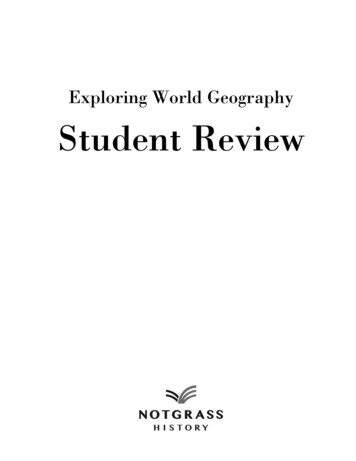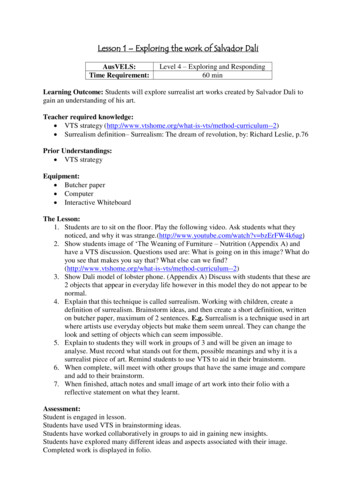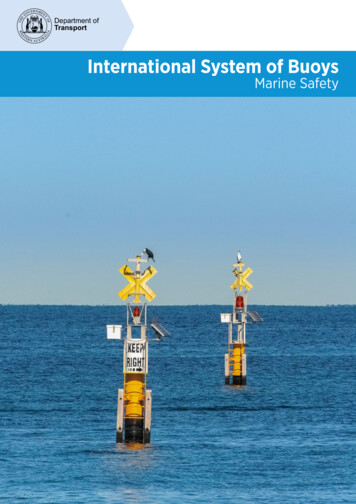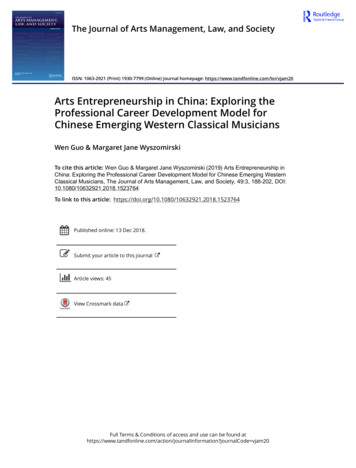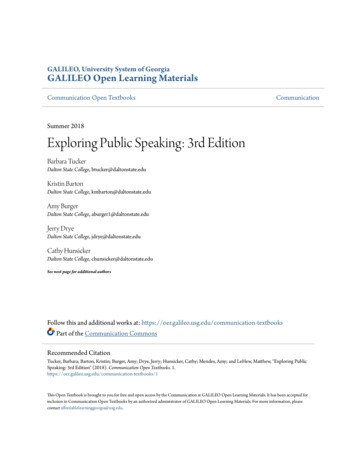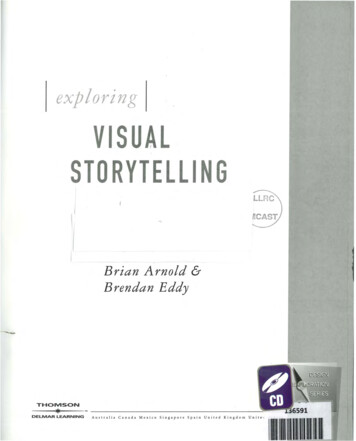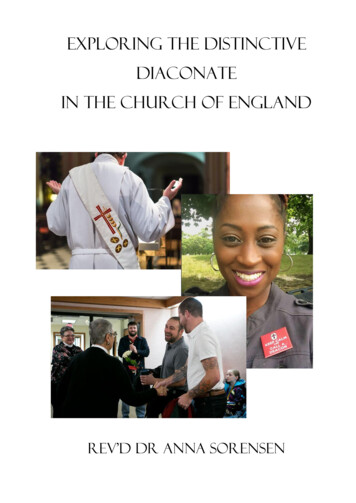
Transcription
Exploring the distinctivediaconateIn the church of EnglandRev’d Dr Anna Sorensen
2IndexINTRODUCTION31SOME HISTORY62WHAT DOES THE MINISTRY OF A DISTINCTIVE DEACONLOOK LIKE?123WORKING WITH OTHER MINISTRIES284DISCERNING A VOCATION TO THE DISTINCTIVE DIACONATE36MINISTRY DIVISION SELECTION CRITERIA39DIGRESSIONS40BIBLIOGRAPHY46 2021 Reverend Dr Anna SorensenBible quotations are from the New Revised Standard Version unless otherwise stated.Cover images: Google imagesI actually find that although people outside of the church or on the fringe haven’theard of deacons, they actually will understand sometimes better what it is, becauseas far as most people are concerned, deacons are actually doing the sort of thing thatthey think Christians should be doing; that sort of being on the fringes and turningthe tables. Rita.I love this dismissing, go in peace to love and serve the Lord All that about tryingto enable discipleship for people out of church, so the liturgy after the liturgy, that’swhat they describe diakonia as, don’t they? (with enthusiasm). Julian.I sometimes use the image of deacons being a bit like a post-it note on the church,about the baptismal call of all Christians that we neglect; that sense of calling todiakonia and to serve and not to be served, that all Christians need to be enabled with.Rita.My junior priest colleague, who can be who is very bright but dense, said, ‘oh yes,inferior office, that’s from the ordinal, isn’t it?’ Don’t put me down! (Exasperation).Junia
3IntroductionThe ordained ministry of the Church of England consists of three orders – deacon, priest andbishop. Since the fourth century the diaconate has mainly existed as a transitional order, withdeacons becoming priests after a short time. There have been one or two exceptions in thecourse of the history of the Church of England, the main one being the foundation of theDeaconess Order, which played an important part in the ministry of the church between 1861and 1987. However, since 1987, when women were first admitted to the ordained order ofdeacon, there have been a slowly increasing number of deacons who have remained in thatorder of ministry, and are referred to, in the main, as distinctive deacons. Distinctive deaconsare also referred to as permanent deacons, but this term is used less frequently, and can bemisleading, as it is perfectly possible, and not unheard of, for a distinctive deacon to befurther called, in time, to priestly ministry. There are those, including some distinctivedeacons, who feel that they should just be called deacons, without a qualifier, as the ones whoinhabit this ministry long term. In my heart I agree, but can see the practical difficulties atthis time, when then number of distinctive deacons is small, and the number of transitionaldeacons (those who are priested after a year) is much greater. The term distinctive deacon isthe one used by the Ministry Division of the Church of England. The distinctive diaconatehas a firm basis in the New Testament, and the need for such an order of ministry is as strongtoday as it was then. As you will see from the way that distinctive deacons describe theirministry below, that they are passionate about what they do, and fulfil a valuable ministrywithin the Church of England.This booklet arises in part, from my own experience of having been a deacon in the Churchof England; also, from a deep respect for this undervalued third order of ordained ministry;and finally, from my wish to see it flourish. I want to offer you encouragement andinformation if you think you may have a calling to be a distinctive deacon. When I wasdescribing this project to my daughter, who is a theatre producer with a brief that includesworking with the community, she said, ‘oh, you mean promotional material.’ On reflection Idecided that was a good description. I very much want to promote the distinctive diaconate.At 11 years old, I went away to school. It was an Anglican Convent School, and I loved it. Iwas nurtured in the Christian faith and the Sisters were wonderful role models. In the courseof my time at school I felt a strong call to ordained ministry. This was in the 1970s and myintention to become a priest was greeted with some hilarity by my peers. However, the calldid not disappear, and in 1983 I went to theological college to train to be an accredited layworker – one of the stipendiary roles open to women at that time. In 1987, when women were
4admitted to the diaconate, I was working in a parish and my training incumbent helped me toexplore what the ministry of a deacon might look like. Although a large number of womenwere being ordained deacon in that year, very little guidance was given by the Church ofEngland about the nature of the diaconate, and so I was very grateful for the support andencouragement that Fr Charles Lawrence offered me. We both suspected that it would besome time before women were admitted to the priesthood – a far more contentious move bythe Church. In 1994 women were made priest for the first time, and after a lot of soulsearching, I was one of them. I had felt fulfilled in my ministry as a deacon, but it was madeclear to me that if I remained a deacon there would be no stipend, and by this time I wasmarried, with one child and another on the way. I needed to be earning. I have not regrettedmy priestly ministry, but my time as a deacon has left me with a deep respect for thediaconate and a wish to see it well used and respected within the Church of England.In the course of my exploration of the diaconate in the Church of England, I have beensurprised to discover that there is very little material written by deacons about their ownexperiences of calling and ministry. While the corpus of material about deacons is greaterthan I expected, the voices of deacons themselves are rarely heard. The only places where Ihave found the voices of distinctive deacons, apart from direct conversation, are on websitesthat have been created by distinctive deacons for other distinctive deacons or those lookingfor information about discernment. These include ‘Deacon Stories’(https://deaconstories.wordpress.com), which has a wealth of material, including theexperience of deacons, as well as information about discernment, training and ordination.In 2012 I decided that I needed to return to academia before my brain rusted up completely,and finding the voices of deacons seemed a worthwhile thing to do. Therefore, my doctoralthesis became an exploration of what it means to be a distinctive deacon in the Church ofEngland today, and I worked with sixteen active distinctive deacons, recording their viewsand experiences. Enabling them to tell their stories, and share their perspective of theirministry was a great privilege. With 1001 distinctive deacons in all, in the Church of Englandat the time I was doing my research, it was tempting to try to approach all of them. But timedid not allow, and I was keen to build a rich picture of this ministry, delving deeper into theministries with a smaller data set. I therefore drew together a respondent group that was1The number of distinctive deacons has always been difficult to ascertain, as previously they were notdifferentiated from other clergy groups in Church of England statistics. Gill Kimber found 165 within theChurch of England in 2019, and since then has persuaded the Church to keep a separate statistic of distinctivedeacons. This however, is only as good as the Dioceses who provide the information.
5representative of the order as a whole. I have included the words of these deacons in thefollowing chapters.The members of the respondent cohort were very frank about the issues that they faced.Given that the clergy of the Church of England are a close-knit group in terms of informationsharing, and that there were only one hundred distinctive deacons, some of distinctive deaconswere anxious that what they had said would become general knowledge, once my thesis wasin the public domain. They felt that this might impact on their ministry, especially in dioceseswhere they felt that they were already under sufferance as distinctive deacons. To protect therespondent cohort, I anonymised the interview transcriptions, and each respondent was givena pseudonym. As far as possible I chose the names of people, including deacons and bishops,who were active in the Early Church. Despite these precautions, a few of distinctive deaconsfelt that they could be identified, none-the-less. They still chose to take part in the project,and I am grateful for their courage in doing so. I have used the pseudonyms in this booklet.Although the respondent cohort were representative in gender balance, age and distribution ofthe wider diaconate, and from other conversations that I have with distinctive deacons, Ibelieve that the voices I have recorded do faithfully represent the distinctive diaconate in theChurch of England, I accept that they do not represent the views and experiences of alldistinctive deacons.Happily, the voices of distinctive deacons have become stronger and clearer in the time sinceI undertook my research. Much credit for this goes to Revd Deacon Gill Kimber. She has notonly engagingly recorded her own experiences of ministry as a distinctive deacon for overthirty years in her book, Deacon by Design: the ups and downs of an Anglian Deacon; but hasalso done much to raise the profile of the distinctive diaconate, and to create platforms formutual support among distinctive deacons. Ministry Division, too, has engaged with theparticular discernment needs for distinctive deacons, and this is reflected in specific selectioncriteria and new information about the diaconate. These can be found on the Church ofEngland website, and the links are also given later in this booklet.I have tried to create a resource that is user friendly and not too long. However, I havesuccumbed to the occasional digression. These are referenced in the text and appear at theend of the booklet. If they provoke your interest, read them; if not, ignore them. I havesuggested further reading and offered questions for reflection at the end of each chapter.
61Some historyThere are books which offer a comprehensive history of the diaconate, and I have includedthem in the reading at the end of this chapter. What I offer here is a brief overview of theorigins of the diaconate, as well as the correction of a misreading of Scripture which has leftus with an understanding of the diaconate which begins and ends with the word servant.I regularly speak with people who tell me with great certainty that the first deacons in theChurch were the seven Greek men chosen for ministry in Acts 6.1-4. In this passage there arethree words from the root diakon-. In the NRSV Bible they are translated variously as dailydistribution of food, waiting at tables, and serving the word. However, John Collins, who hasmade an in-depth study of the treatment of diakon- words, both in the New Testament and incontemporary secular texts, has shown that diakon- words were usually translated ascommission, mandate, agency, emissary or envoy.2 He felt that to translate these words sovariously within this one passage is strange, to say the least. Collins points out that there is nomention of food in the passage, that the issue over the distribution of wealth had been dealtwith in Acts 4; and that it would be logical and reasonable to translate all three diakon- wordsin the same way, as service of the Word or ministry.Collins then applies this to the text to form the following reading:Taking the liberty of paraphrase, and including a number of explanatory phrases, wemight re-read Luke’s account of the Seven in the following way:The Greek-speaking members of the community complained against those who spokeAramaic that their housebound widows were being overlooked in the great preaching(diakonia) that was going on day by day in the environs of the Temple. So, theTwelve summoned the whole complement of the disciples and said: “We cannotpossibly break off our public proclamation before the huge crowds in the Temple tocarry out a ministry (diakonein) in the households of these Greek-speaking widows.Brothers, you will have to choose seven men from your own ethnic group who arefully respected, empowered by the Spirit, and equipped for the task. We will thenappoint them to the role that needs to be filled. That will mean that the Twelve can geton with attending to worship in the Temple and to our apostolic ministry (diakonia) ofproclaiming the Word there.” (Collins 2002, 58).According to this translation the seven Greek-speaking men were chosen as another group ofapostolic ministers, to heal divisions that were beginning to appear between the Hellenist2Collins, J. N, (1990): Diakonia: Re-Interpreting the Ancient Sources. This was ground-breaking work,allowing for a re-examination and reconstruction of the true nature of the diaconate.
7believers, and the Hebrew believers. This makes sense of the public preaching role assumedby Stephen; and it is endorsed by James Munroe Barnett, who acknowledged that they wereappointed as leaders of the Hellenist faction, and that their activity, in the end, was not verydifferent from that of the Apostles (Barnett 1979, 29).Sadly, the seven Greek men are still serving food in most translations of the New Testament,and assumed to be deacons. But if that is not the origin of the Order of Deacons, where do wefind it? Like all ministry, the diaconate has its roots in the ministry of Jesus himself, who asGod incarnate had a commission of preaching, teaching, healing and sacrifice. But this is nottranslated into specific ministries within the New Testament, until the pastoral epistles. Mostof the information regarding a named ministry of deacon is to be found in 1 Timothy 3. Herethe ministries of overseer or bishop and deacon require the same qualifications. These arestrict, because of the respect in which these offices are held (Barnett 1979, 40). While it isclear that the office of bishop had precedence over that of deacons, it would be misleading tosee deacons as assistants of the bishop. They were colleagues, whose main role was todispense the Church’s charities to the poor and the sick, keep order during worship, and toplay specific roles within the liturgy. The main flourishing of the diaconate was during thefirst five centuries CE. There are references to deacons in the writings of the ApostolicFathers as well as in accounts of the Ecumenical Councils. Deacons oversaw the pastoral careof the Church; administered charities; acted as secretaries to bishops, often succeeding themin office; according to one account representing their bishop at an ecumenical council; andhaving a vital role within the liturgy of the Church (Barnett 1979, 43).But by the fourth century the central role of the deacon in the Early Church was beginning tobe seriously undermined. James Munroe Barnett charts the end of what he considers thegolden age of the diaconate. The conversion of the Emperor Constantine to Christianity led toImperial patronage and the unprecedented growth of the Church. The influx of so many newchurch members led to major organisational changes. The new organisation took the Imperialstate as its model. The use of the title ‘pontiff’ assumed by metropolitan bishops, the use ofvestments and the carrying of candles, are all drawn from pagan sources. While bishopspresided over groups of church communities, and were assisted by archdeacons,individual/local church communities were now led by a presbyter in place of the bishop, andthe deacons now worked with the presbyter, where before their ministry had been bound upwith that of the bishop. The only offices which required the presence of a bishop wereordination and confirmation. The Council of Antioch in 325CE demoted rural bishops,
8making them subject to their metropolitan colleagues. The Council of Laodicea in 336CEconfirmed a range of minor orders, and in an increasingly hierarchical church, deacons weredeemed inferior to presbyters. Whereas, previously, it had been possible for deacons tobecome bishops, now that was only possible via ordination to the presbyterate. Thishierarchical structure was known as the cursus honorum. As liturgy and ritual became morecentral and complex, the role of presbyter became more important. As deacons lost authority,their role in the liturgy also diminished. Presbyters were still ordained deacon, but the focuswas on the next ordination in the hierarchy - to the presbyterate (Barnett 1979, 88-124).After ordination to the diaconate, they served as apprentice priests, not as deacons,except for having a liturgical function largely restricted to that of the ancient diaconate. The Church had in effect created a different office, the transitional diaconate, evenif it masqueraded under the same name (Barnett 1979, 124).The ‘humble’, ‘inferior’ and ‘transitional’ deacon had been created. The influence of this viewof the diaconate in subsequent centuries, and in particular after the inception of the Church ofEngland, can be seen in her earlier Ordinals, which refer to the diaconate as an inferior office,compared to higher ministries.Digression One – ordinals before 2007 (see page 40)Because deacons has come to be seen as assistants to parish priests, and the diaconal ministryas a preparatory period before priesting, rather than as a specific ministry in its own right, theChurch of England tended to consider the role or usefulness of deacons only at times ofnecessity; when there were insufficient priests, or when the needs of the church community orthe wider community has swiftly increased, or when it has proved politically expedient (as inthe case of the debate around the ordination of women). Thus in 1560 Archbishop MatthewParker, concerned about the number of parishes which were vacant, issued an ‘Order forserving cures now destitute’ (Strype 1828, 138). Parker’s Order instructed that the principalincumbent in cases of plurality was to depute a deacon to read the order of service appointed,or else depute a suitable layman to do so, as lector or reader. Francis Young notes that whilethe established Church in the late sixteenth century was occasionally using deacons assubstitutes for priests and appointing them to livings, the puritans, following Calvin’s patternof ministry, appointed deacons to a more pastoral role, without ordination (Young 2015, 1516). However, there is no evidence of a thriving permanent diaconate at any time within theChurch of England until the nineteenth century and the founding of the Deaconess order.
9The nineteenth century saw massive social change, brought about in great part byindustrialisation, which impacted on the ministry of the Church of England. Poor housing,overcrowding, inadequate sanitation and the breakdown of social structures, caused massivesocial – and with them pastoral – problems. In 1850, William Hale, Archdeacon of London,published a consideration of The Duties of the Deacons and Priests in the Church of Englandcompared, emphasising the need for an extension of Christian ministry to meet the needs ofthe growing urban church.Despite the pleas by Hale and others for permanent deacons, the Convocations of bothCanterbury and York resolved instead to restore the office of Reader, another, though lesswell documented, Early Church ministry; and on 10 May 1866, the Archbishop and Bishopsof both provinces sanctioned a form of licence for Readers, which has formed the basis for thelicence for Readers in general use in the Church of England ever since. However, the focus ofReader ministry was not on pastoral care among the poor and needy, but on Christianteaching, and leading prescribed parts of divine service, and, for those of a good generaleducation, preaching.By the mid-nineteenth century the influence of the revived Deaconess Order by TheodorFleidner at Kaiserswerth, Germany, was being felt in most northern European countries, andEngland was no exception.Digression Two - The influence of Kaiserswerth (see page 41)In 1861, with the strong support and guidance of the then Bishop of London, ArchibaldCampbell Tait, Elizabeth Ferard was admitted as the first deaconess in the Church of Englandand the sister in charge of the North London Deaconess Institution (NLDI). Between 1869and 1907 fourteen more deaconess institutions were established, across England. Theyundertook teaching, nursing, pastoral visiting, adult education, training domestic servants, andministering in prisons and asylums. The number of deaconesses increased steadily between1861 and 1919, from 15 to 105 (Blackmore 2007, 131-133). Nevertheless, as the 1865 annualreport of the NLDI testifies, the number of deaconesses available was insufficient to meet theapplications for their services from parishes, asylums, hospitals and prisons. The deaconessorder was, to all intents and purposes, a distinctive diaconate. It gave formal diaconalministry a place within the church hierarchy, and a century later this provided a platform forthe ordination of women as deacons, in 1987.
10By June 1987 there were 750 female and 13 male distinctive deacons in the Church ofEngland. These included about 700 former deaconesses, and those who had just finishedtraining for the diaconate. They could be described as ‘distinctive’ in so far as they could not(in the case of many of the women) or did not intend to (in the case of the men and a few ofthe women) continue to priestly ordination. While admitting women to the diaconate lookedlike a move forward for the ministry of deacons, the context in which they were ordaineddeacon was in fact detrimental, as so many of these deacons were waiting to be priested, andhad no interest in exploring or developing a deacon’s ministry. At the same time, thedeaconess order, which had been a strong focus of diaconal ministry was disbanded, as beingno longer necessary. No attempt was made at this stage to create a support system for thosewho felt called to the distinctive diaconate. Previously, the interests of the deaconesses hadbeen represented in Church House by a senior deaconess, appointed for that purpose, whoalso oversaw accredited lay ministries. Once women were ordained deacon this postdisappeared, and deacons had no specific representative. Deacons were members of theHouse of Clergy; however, since the majority of members of the House of Clergy werepriests, and the majority of the deacons were waiting and wanting to become priests, thedistinctive deacons became a voiceless minority in a setting which was, in reality, the ‘Houseof Priests’. This revealed an (on-going) anomaly in the synodical structures of the Church ofEngland in relation to the three-fold ministry: while there is a discrete House of Bishops, asimilar provision is not made for a ‘House of Deacons’.In the intervening 34 years there have been a series of reports commissioned by various armsof the Church of England, to consider whether the Church should support the development ofa Distinctive Diaconate in the Church of England.Digression Three – working parties and reports (see page 42)In the main the view has been that a properly trained and resourced distinctive diaconatewould be of benefit to the Church, and sincere, well-thought-out recommendations have beenput forward. However, it is only recently that the development of the distinctive diaconatehas begun to show signs of vigour, and that has been through the determination of distinctivedeacons themselves, rather than the institutions of the Church. The rejection of the report,For Such a Time as This, by General Synod was a blow to distinctive deacons alreadyministering in the church. Gill Kimber says that the Diaconal Association of the Church ofEngland (DACE), which had been founded when women were first ordained deacon, began to
11lose vision, purpose and adherents, and closed in 2017. Gill began a DEACON blog, and thena Facebook page, a WhatsApp group and a Twitter feed. When the Church of Englandrefreshed its website, Gill wrote the script for the section of the ministry and vocations pageconcerning distinctive deacons. In 2018 seventeen deacons were ordained in York Diocese,following an initiative by Archbishop Sentamu and Deacon Liz Carrington, and in the sameyear the first national conference for distinctive deacons was held, endorsed by both theArchbishops, and attended by a Ministry Division representative. Gill has gathered an activeand enthusiastic team, and the support of several bishops. Regional groups are being rolledout, and the number of people discerning a vocation to the distinctive diaconate is on the rise.It is hoped to persuade the House of Bishops to take a unified stance in supporting distinctivedeacons, rather than the piecemeal one of the past. To access all this new and excitinginformation, and a lot more, visit https://deaconstories.wordpress.comFurther readingBarnett, J. M. (1979): The Diaconate: A Full and Equal Order (Valley Forge: Trinity PressInternational).Blackmore, H. (2007): The Beginning of Women’s Ministry: The Revival of the Deaconess inthe Nineteenth Century Church of England (Woodbridge: Boydell).Brown, R (2017): ‘Expanding the Theological Foundation of the Deacon’s Ministry,’Ecclesiology 13, 197-223Collins, J. N. (2002): Deacons and the Church: Making connections between old and new(Leominster: Gracewing).Diocese of Salisbury (2003): The Distinctive Diaconate. (Salisbury: Sarum College Press).Kimber, G. (2015): ‘A Potted History of the Diaconate.’ Available 015/07/A-potted-history-of-the-Diaconate.pdfYoung, F. (2015): Inferior Office? A History of Deacons in the Church of England(Cambridge: James Clark & Co).Questions for reflection1How does John Collins’ reading of Acts 6.1-4, and his assertion that all thebaptised are called to a ministry of service, while deacons are commissioned for aparticular ministry, affect your understanding of your own vocation?2Given the major issues that are faced by societies in the modern world, what mighta flourishing distinctive diaconate bring to missional ministry, which is not alreadythere?
122What does the ministry of a distinctive deaconlook like?The central description of the role of an ordained minister in the Church of England is to befound in the Ordinal for each order. The ministry of a deacon, as found in the most recentOrdinal - the Common Worship Ordinal (2007), is described in this way:To serve this royal priesthood, God has given various kinds of ministries. Deaconsare ordained so that the people of God may be better equipped to make Christknown. Theirs is a life of visible self-giving. Christ is the pattern of their callingand commission; as he washed the feet of his disciples, so they must wash the feetof others.Deacons are called to work with the Bishop and the priests with whom they serveas heralds of Christ's kingdom. They are to proclaim the gospel in word and deed,as agents of God's purposes of love. They are to serve the community in which theyare set, bringing to the Church the needs and hopes of all the people. They are towork with their fellow members in searching out the poor and weak, the sick andlonely and those who are oppressed and powerless, reaching into the forgottencorners of the world, that the love of God may be made visible.Deacons share in the pastoral ministry of the Church and in leading God's people inworship. They preach the word and bring the needs of the world before the Churchin intercession. They accompany those searching for faith and bring them tobaptism. They assist in administering the sacraments; they distribute communionand minister to the sick and housebound.Deacons are to seek nourishment from the Scriptures; they are to study them withGod's people, that the whole Church may be equipped to live out the gospel in theworld. They are to be faithful in prayer, expectant and watchful for the signs ofGod's presence, as he reveals his kingdom among us (CHP 2007, 10, 15).It can be seen that the role of deacons within the Church of England, as set out in the Ordinal,is multi-faceted, and this is reflected in the descriptions given by distinctive deacons of theministries which they inhabit. The Ordinal describes a ministry which is collegial, andexercised on the peripheries of the Church community. Deacons are called to work withepiscopal and priestly colleagues to be heralds of Christ’s kingdom. The duty to share in the
13proclamation of the Gospel, to preach and to care for the poor and outcast is shared by allthree orders.Comparing the ordinals for the three orders of ministers, it can be seen that the priest and thebishop are both called to be shepherds of the people of Christ, serving them and caring forthem. They are ministers of word and sacrament, although the bishop is the principal ministerand she or he alone can confirm or ordain. They have oversight of the church and they have adisciplinary role. Those who have strayed and return are offered the opportunity forconfession and absolution by bishop or priest. Bishop and priest discern and foster the giftsof the Holy Spirit, and the bishop commissions the followers of Christ to minister in his name.Bishops and priests, then, are ordained to a ministry in which oversight of the Churchcommunity and administration of the sacraments predominates.Deacons, by comparison, are called to a ministry which has greater connection with theoutward mission of the Church, and the people of God beyond the Church community. It is aministry of visible self-giving, which acts as a pattern for the discipleship and mission of thewhole people of God. It is a ministry which equips God’s people, so that they too can live outthe Gospel. Deacons are to proclaim the Gospel in deed as well as word.The Church of England has taken notice of the work of John Coll
1 The number of distinctive deacons has always been difficult to ascertain, as previously they were not differentiated from other clergy groups in Church of England statistics. Gill Kimber found 165 within the Church of England in 2019, and since then has persuaded the Church to keep a se

